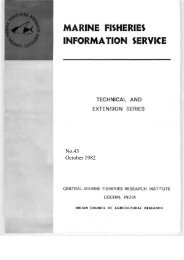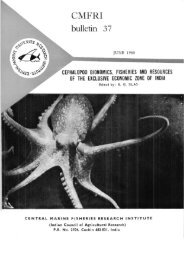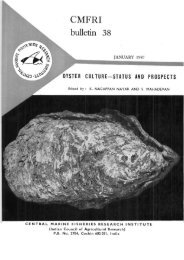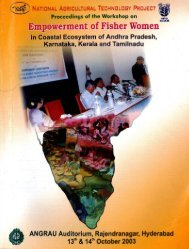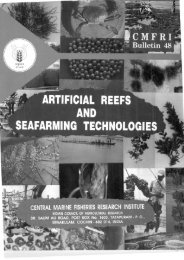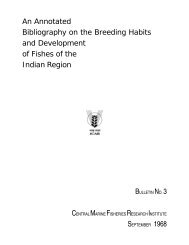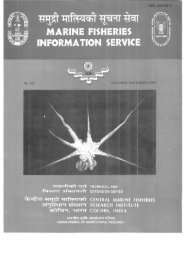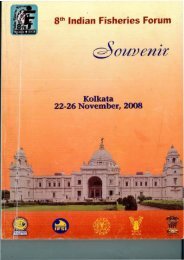pearl culture - Eprints@CMFRI - Central Marine Fisheries Research ...
pearl culture - Eprints@CMFRI - Central Marine Fisheries Research ...
pearl culture - Eprints@CMFRI - Central Marine Fisheries Research ...
You also want an ePaper? Increase the reach of your titles
YUMPU automatically turns print PDFs into web optimized ePapers that Google loves.
12PROSPECTS FOR SELECTIVE BREEDING OF PEARL OYSTERS IN INDUT. S. VELAYUDHAN^INTRODUCTIONRecently a variety of approaches has been introducedin the field of genetics of molluscs, including Mendeliangenetics, cytogenetics, quantitative genetics, biochemicalgenetics and hybridization. Wada (1975 a, b, 1985) hasestimated the response to selection for several attributesof Pinctada fucata for sheU variance of full siblings.He analysed the genetic variability and gene frequenciesat three loci in two strains selected for four to fivegenerations. The change of frequencies of colour ofnacre in the selected lines of <strong>pearl</strong> oyster to yellowprismatic layer for five generations has been studied(Wada, 1985). Wada (1976, 1985) and Wada andKomaru (1985) have studied the chromosomemorphology of different species of bivalves.VAWATIONS IN INDIAN PEARL OYSTER POPULATIONIn India, Alagarswami et al. (1983) artificially produced<strong>pearl</strong> oysters from wild brood. Ala^rswamiand Chellam (1977) have reported the change of formand dimensional relationship in the <strong>pearl</strong> oyster P.fucata from Tholayiram, Pulipimdu and Kudamuthupaars and compared the regressions of different shellcharacters in young and adult oysters from the threepaars which indicated the heterogenous nature of thepopulation. Homell (1922) stressed the need for aknowledge of the special growth peculiarities of <strong>pearl</strong>oysters from the different beds since some paars byreason of abundant food supply hasten the growthof oysters to surprising degree, while others wher? lessfavourable conditions prevail have oysters of an unhealthyappearance and stunted size. Herdman (1905)reported that the <strong>pearl</strong> oysters from Cheval paar (SriLanka) v^ere fairly evenly distributed and in qualitythey proved to be best of all those examined or fished.They were all well grown, healthy and richer in good<strong>pearl</strong>s than any other. For <strong>pearl</strong> <strong>culture</strong> an accurateknowledge of the various traits of the oysters fromdifferent paars is necessary ia order to pick up thenecessary traits to be developed in the brood stock.The <strong>pearl</strong> oysters P. fucata and P. sugillata VKKsuccessfully crossed at the <strong>Central</strong> <strong>Marine</strong> <strong>Fisheries</strong><strong>Research</strong> Institute and viable spat were produced.P. fucata without black lamellar growth on the outershell were produced by inbreeding. Attempts havealso been made to produce cent percent P. fucatawith black lamellar growth on the outer shell by inbreeding.SELECTIVE BREEDING AND HERTTABIUTY OFPEARL OYSTERAccording to Wada (1975 a, b, 1985) the estimatedheritability of the shell size of P. fucata was greaterat one year of age than at two years but not muchdifference was observed in the shell shape. Wada(1985) has mentioned the heritability of the shell traitto be about 0.22-0.25 and that selective breeding of thetrait would be effective for other shell traits sudi asshell beiglht and shell width also. Wada has reportedthe change of frequencies of colour of nacre in theselected lines of <strong>pearl</strong> oyster to yellow prismatic layerfor 5 generations. No significant difference was observedin the mortality of <strong>pearl</strong> oysters and the rate oflow grade <strong>pearl</strong>s between two groups such as whiteand yellow prismatic layer secreting forms. Wada(1985) specifically mentioned the frequency distributionof shell weight of three year old <strong>pearl</strong> oyster of backcrossed (TNT,,NTT and the selected TL) lines in the' Present address : CMFRI, <strong>Research</strong> Ceatre, Tuticorin.628001,CMFRI BULLETIN 39 87




